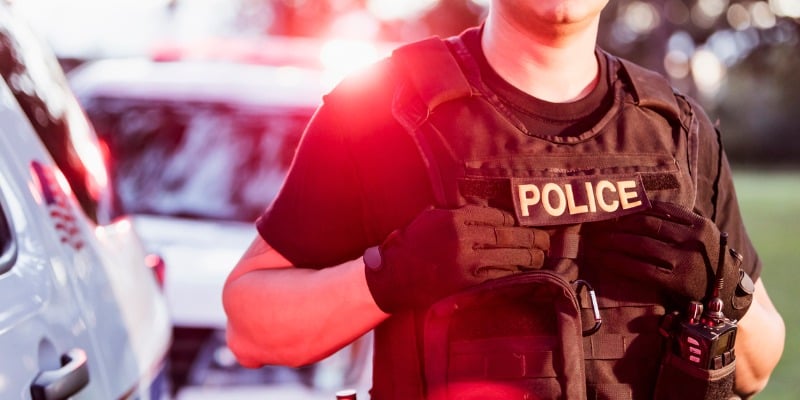
There’s no question police officers have a very hazardous job. Every officer undergoes extensive training to be prepared for the possible dangers of dealing with an armed suspect, a hostage situation, or a robbery in progress. But they may not be fully aware of the threat associated with on-the-job concussions and traumatic brain injuries (TBIs).
Over 2 million new head injuries occur in the U.S. every year, according to the CDC. Although there aren’t specific statistics available on the prevalence of TBIs among law enforcement personnel, a 2018 study in the American Journal of Preventive Medicine does show that officers are three times as likely to suffer a nonfatal injury than all other U.S. workers.
Even though most people are familiar with some of the physical effects of TBIs, very few know that they are also a major cause of psychiatric illness. Even in the medical community and the mental health field, this fact remains hidden. In large part, there are two main reasons why:
1. Traditional psychiatrists rarely ever look at their patients’ brains, so they don’t make the connection between mental health and brain health.
2. The brain imaging tools medical professionals typically use to assess a TBI, such as MRI or CT scans, look only at the brain’s structure, not its function. This results in many people with TBIs being told their results are normal, even though they may be experiencing symptoms that are anything but normal.
Common Causes of TBIs in Law Enforcement
Police officers are vulnerable to a wide range of head injuries. Some of the common causes of TBIs among police officers include:
- Vehicle crashes
- Falls
- Intentional or accidental blows to the head
- Explosive forced entry
- Flashbang devices
- Chronic exposure to low-level blasts
Research on military veterans shows that repetitive low-level blasts can cause TBIs even if they didn’t experience symptoms associated with a concussion. Tactical law enforcement personnel are also repeatedly exposed to low-level blasts and need to be aware of the consequences.
What Happens in the Brain After Physical Trauma?
Many people think the brain is rubbery and fixed within the skull, but it isn’t. In fact, the brain is soft, about the consistency of soft butter, tofu, or custard—somewhere between egg whites and gelatin. It floats in cerebrospinal fluid and is housed in a very hard skull that has many sharp bony ridges. As such, it is easily damaged.
Whiplash, falls, and blows to the head can cause the brain to slosh around, slamming into the hard ridges inside the skull. In the event of a blast, a sharp rise in atmospheric pressure sets off shock waves within the brain. These temporary effects can lead to long-term harm.
This can cause a cascade of brain injuries, including:
- Bruising
- Broken blood vessels and bleeding
- Increased pressure
- Lack of oxygen
- Damage to nerve cell connections
- Ripping open brain cells that spill out proteins like “tau” that cause inflammatory reactions
In addition, the pituitary gland, which regulates hormone production, is located in a vulnerable part of the skull and is often damaged in head injuries. This can cause major hormonal imbalances that are also linked to mental health issues.
Functional brain scans, such as brain SPECT imaging, can reveal signs of TBI in the brain. Typically, SPECT findings in TBIs include areas of decreased activity from the injury in addition to injuries in a contra-coup (opposing area) pattern. In some cases, there may be excessive activity seen in the site of an injury.
Recognize the Signs and Symptoms of TBIs
In some people, the signs and symptoms of a TBI or concussion develop immediately. In others, it may be days, weeks, months, or even years before symptoms emerge. In still other people, no symptoms surface until a second or third head injury triggers a problem.
It’s important to understand that there are physical, sensory, mental, cognitive, and behavioral symptoms associated with head injuries.
Physical and Sensory Symptoms:
- Loss of consciousness
- Feeling dazed or disoriented
- Fatigue
- Trouble sleeping
- Sleeping more than usual
- Problems speaking
- Sensitivity to noise and/or light
- Vision problems
- Ringing in the ears
- Dizziness
- Balance problems
- Nausea
- Headaches
- Changes in sense of smell
Mental and Cognitive Symptoms:
- Confusion
- Difficulty concentrating
- Trouble paying attention
- Memory problems
- Difficulty with word-finding
- Mental fatigue
- Mood swings
- Anxiety
- Depression
- Impulsivity
Behavioral Symptoms:
- Social withdrawal
- Angry or violent outbursts
- Drug or alcohol abuse
When symptoms persist, they can lead to other consequences. Cognitive problems, aggression, impulsivity, and other issues can put officers at serious risk of other injuries, including additional head injuries.
Head Injuries and Mental Health
Law enforcement personnel need to be aware that TBI has been linked to depression, anxiety, panic attacks, ADD/ADHD, learning problems, memory problems and dementia, school failure, job failure, homelessness, drug and alcohol abuse, domestic violence, psychosis, borderline personality disorder, murder, and suicide.
The problem is most people don’t connect the dots between their psychiatric symptoms and a head injury that may have happened years earlier. In fact, many people forget they’ve suffered a significant head injury as amnesia surrounding an accident is common.
Getting Help for TBIs
Unfortunately, trying to treat the psychiatric symptoms alone doesn’t work and won’t until the underlying brain injury is healed. However, adopting a brain optimization program that includes taking measures to protect your brain from future injuries, good nutrition, regular physical exercise, targeted supplements, and new learning is a good place to start. Other treatments that help heal the brain include neurofeedback and hyperbaric oxygen therapy.
- Neurofeedback is an interactive, non-invasive treatment that helps strengthen and retrain the brain to achieve a healthier, more focused state. Research, including a 2017 study on 40 individuals with post-concussion syndrome, shows it is helpful for people with TBI.
- Hyperbaric oxygen therapy (HBOT) is a noninvasive treatment that involves breathing 100% pure oxygen in a pressurized chamber to accelerate the healing process. A brain SPECT imaging study from 2011 on people with a TBI showed significant improvement in mood, impulsivity, anxiety, and quality of life scores following treatment with HBOT.
At Amen Clinics, we have helped thousands of people with concussions or TBIs to heal their brain and minimize their symptoms. We use a combination of the least toxic, most effective therapies, which may include neurofeedback, HBOT, nutraceuticals, and medications, as well as simple lifestyle changes that can make a big difference.
If you have suffered a concussion or head injury, find out how we can help. Talk to a specialist today by calling 888-288-9834 or schedule a visit online.





If you are a first responder don’t bother wasting your money trying this place. They don’t know how to deal with complex trauma and they don’t believe sexual assault victims. It’s hard enough to come forward asking for help but when the Dr. don’t understand ptsd and give you meds to make your symptoms worse it’s not good. To expensive for the services you receive.
Comment by Mary — February 6, 2020 @ 4:23 AM